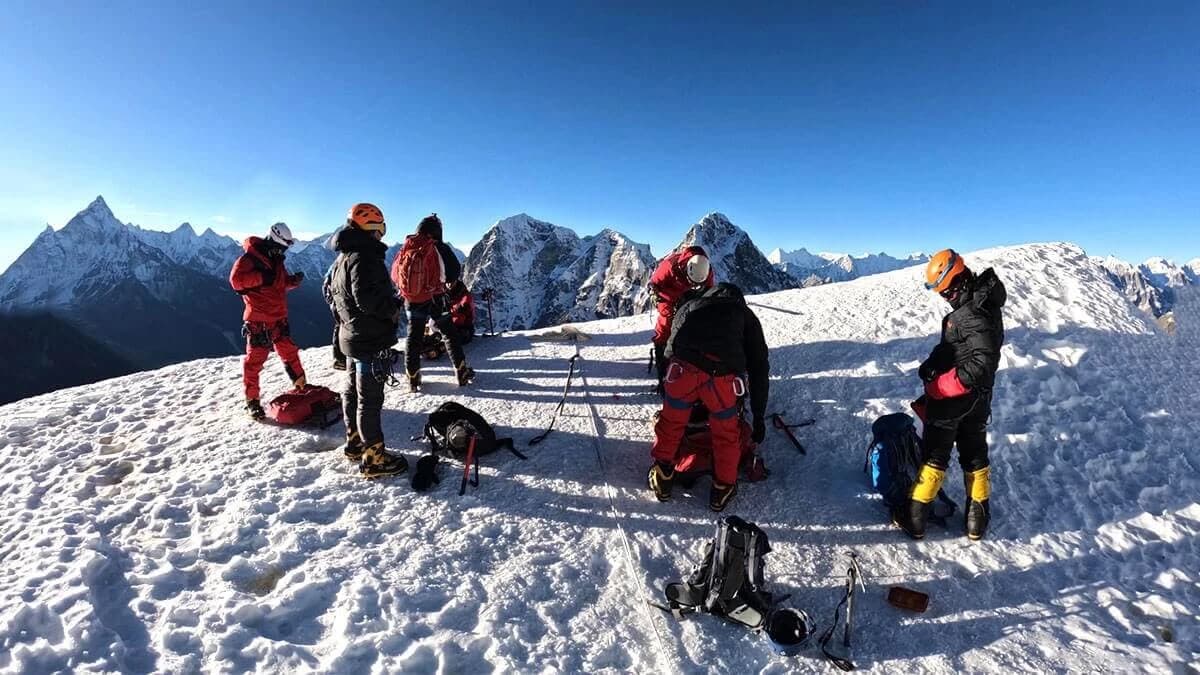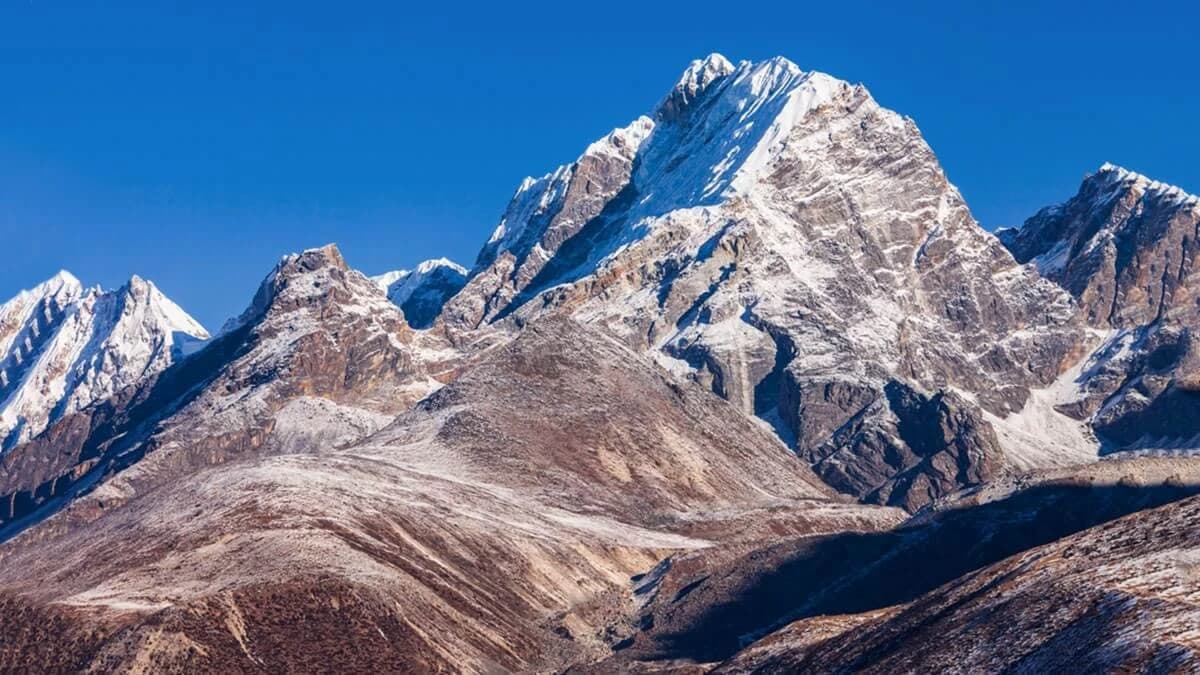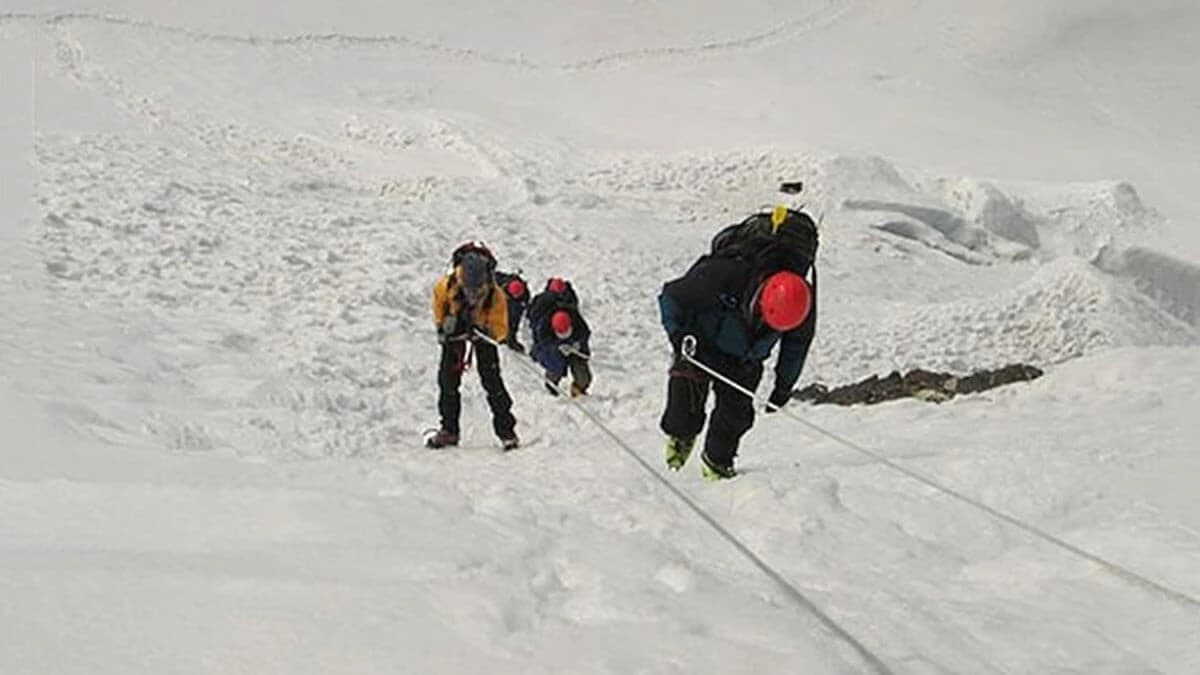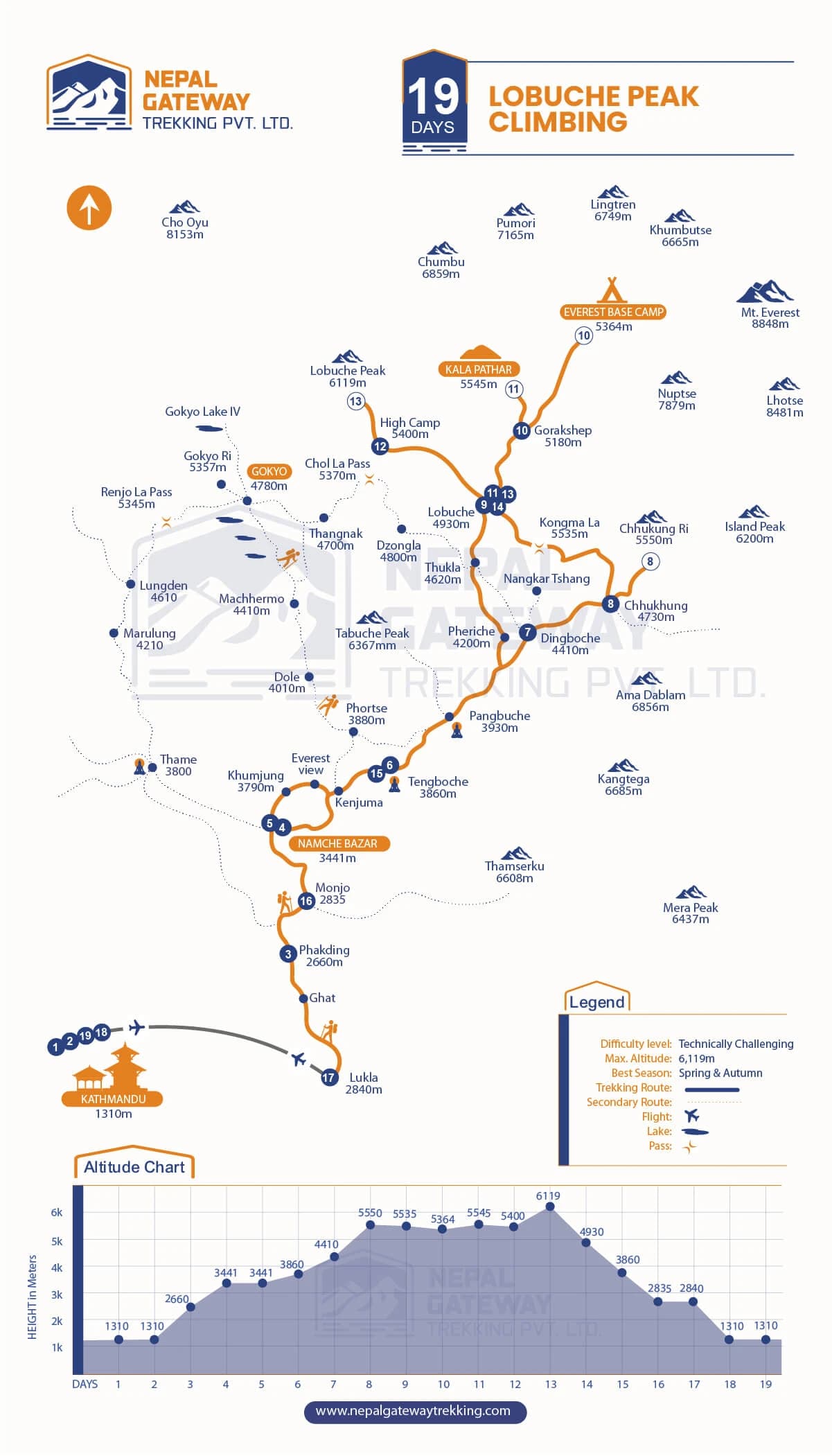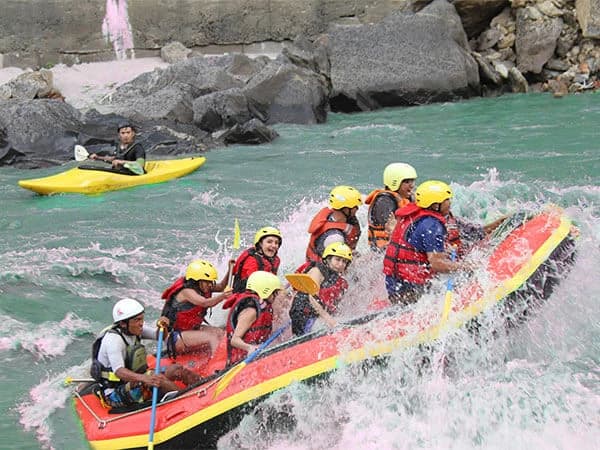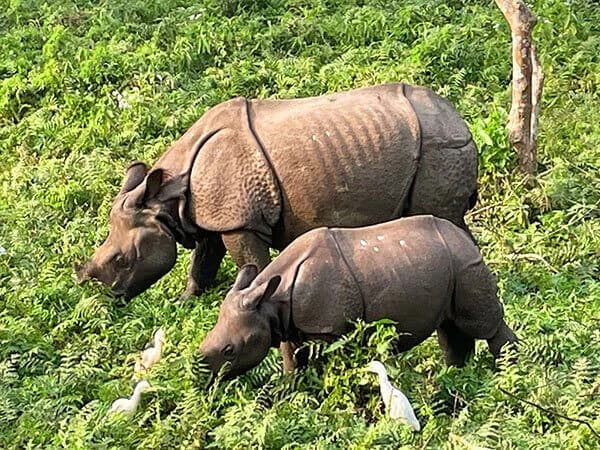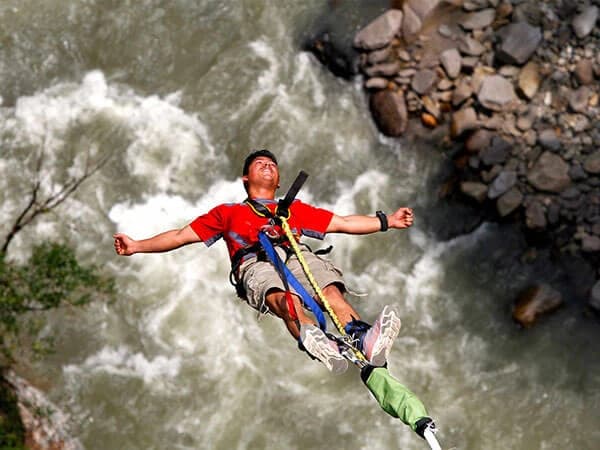Join our expert mountain guides on a tremendous high-alpine adventure to the summit of Lobuche East Peak. En route, hike to Everest Base Camp, relish the spectacular sunrise from Kala Patthar, and cross Kongma La pass while spending nights in picturesque Sherpa villages.
Lobuche Peak Climbing
Lobuche Peak Climbing in Nepal is the best activity for climbing a mountain over 6,000 m. Lobuche Peak is a great mountain to climb on your first Himalayan expedition. It is a 6,119 m tall mountain in the Khumbu region and is classified as a trekking peak. Our Lobuche Peak climbing itinerary combines an excursion to the Everest base camp (the base of the highest mountain in the world) and the famous viewpoint, Kala Pathar.
The climbing route to the pinnacle of this peak doesn't involve major technical sections, and mobility is quite doable, so we highly recommend Lobuche Peak climbing to our climbers with less or no experience.
Even though the technical section is not that demanding, the journey requires a muscular build, high endurance, and willpower. At the same time, you'll need fair mountain awareness, too. Rising high above the glaciers, Lobuche Peak Climbing with Everest Base Camp is one of the most adventurous activities in the Everest region.
You get to witness breathtaking views of Mt. Everest (8,849 m) and other eight-thousander mountains like Lhotse (8,516 m), Makalu (8,463 m), Cho Oyu (8,188 m), and Kanchenjunga (8,586 m).
For mountaineers aiming to climb more technically advanced mountains like Ama Dablam, Everest, and Manaslu, use Lobuche Peak as a training peak. Lobuche East Peak Climbing combines trekking and climbing. You'll be following the famous EBC trail for the first few days of the trip, exploring beautiful villages like Namche Bazaar (3,440 m), Tengboche (3,870 m), and Dingboche (4,360 m). We added a Kongma La pass (5,535 m) crossing to the itinerary, which will help you climb Lobuche East.
The journey is enchanted with tempting landscapes and views of verdant hills, waterfalls, rivers, colorful prayer flags, and snowy peaks. The locals' lifestyle, warm welcome, and rich tradition will give you a sense of home. Far away, amidst the mountains of the Khumbu region, you'll get to unwind and rejuvenate.
The visit to ancient monasteries like Tengboche Monastery and Pangboche Monastery along the way and all these little elements make the Lobuche East Peak Climbing with Everest Base Camp an immersive venture.
Important Note: During the peak season, flights will be operated from Manthali Airport, Ramechhap, to Lukla. In the spring, from mid-March to mid-May and late September to November in autumn, all flights take off and land at Manthali Airport.
The Manthali airport, Ramechhap, is 142 km from Kathmandu, a 4-5 hour drive. To catch a flight to Lukla from Ramechhap, you must depart from Kathmandu from 1 a.m. to 2 a.m.
We highly recommend that you come with at least one more extra day for jet lag, especially considering the early morning drive to Manthali Airport, which benefits from adequate rest and sleep beforehand.
The significant highlights of Lobuche Peak Climbing
- Climb the east summit of Lobuche Peak (6,119 m).
- Walk through lush alpine forests and beautiful Sherpa villages.
- Visit ancient monasteries and come across many stupas, chortens, etc.
- Enjoy diverse mountain landscapes along the way.
- Go on a side excursion to Hotel Everest View and Chhukung Ri.
- Cross a high mountain pass, Kongma La.
- Hike to Everest Base Camp and Kala Patthar.
- Get pre-climbing training from our expert mountain guides at the Lobuche Peak base camp.
- Full support from the crew to help you reach the summit and come back safely.
- Witness stunning views of some of the eight thousand mountains, including Everest, Lhotse, Kanchenjunga, Makalu, and Cho Oyu.
Lobuche East Peak Climbing Route Overview
The Lobuche Peak climbing route involves steep, snowy slopes and rock-fixed line climbing. You'll walk above the Khumbu Glacier from Lobuche Base Camp (4,950 m) to reach Lobuche High Camp (5,400 m). From the high camp, the summit of Lobuche East is only a tough stretch away. The path gets steeper, and you must walk by a sharp snow ridge. Some snow bumps and notches are climbing in the northwest of the peak. From here, you will cross the 45° slope and finally push to the summit.
Why join NGT for Lobuche East Peak Climbing with Everest Base Camp?
At Nepal Gateway Trekking, we tested and ran our Lobuche Peak Climbing itinerary. We are confident in our mountain crew, safety protocol, and the trip experience you'll get. We have the best Lobuche Peak Climbing with Everest Base Camp cost in the market. Likewise, you'll not be bothered by any hidden charges. We have been organizing trips like this for over a decade. You can trust our team.
Itinerary
This is our standard and recommended itinerary for Lobuche Peak Climbing with Everest Base Camp Trek.
We welcome you at the Kathmandu airport and transfer you to the hotel. The remaining day is leisure. In the evening, there is a group meeting organized by the company where you get to meet other team members. You end the day strolling on the bustling streets of Thamel.
Today we will get a climbing permit from NMA for climbing to Lobuche Peak. In the afternoon, we introduce you to your team leader/climbing guide. There will be a small briefing session; check the equipment and prepare for the journey.
Our adventurous trip in the Everest region begins with a thrilling flight to Lukla airport. The mountain views during the flight are stunning. Upon landing at the Lukla airport, you meet your porters and go to the guest house for refreshment before heading to Phakding.
The trail descends alongside the Dudh Koshi River. You pass Chaurikharka, Cheplung, Thade Koshi, and Ghat village to reach Phakding village for the first night in the mountain.
Today, you trek to Namche Bazaar. The trail ascends and descends through dense forests of rhododendron, birch, magnolia, etc. You'll walk by remote villages and cross the Dudh Koshi River numerous times through suspension bridges. You will walk through Toktok, Banker, Manjo, and Jorsalle villages to reach Namche Bazaar. The final ascent to Namche Bazaar is steep and tough.
If you are lucky with the weather, you can see the first glimpse of Mount Everest while ascending the Namche hill. Namche Bazaar is one of the big settlement villages and tourist hubs in the Khumbu region. There are big hotels, restaurants, bakeries, supermarkets, banks, etc.
You spend one extra day in Namche Bazaar to acclimatize your body with thin air and elevation. After breakfast, your guide will lead the trail for today's hiking. Everest View Hotel is the highest point of the hike. The trail is rough, but it offers fantastic views of Mount Ama Dablam and Mount Thamserku.
From Hotel Everest View, you will witness superb views of Mt. Everest, Mt. Lhotse, and Mt. Nuptse. You'll also have the option to continue the hike to Khumjung monastery, or you can descend back to Namche Bazaar to spend the rest of the day.
You leave Namche Bazaar after the breakfast. First, you have a short climb before the trail goes mostly flat to Kyanjuma. The trail offers spectacular views of Mount Everest, Mount Lhotse, Mount Ama Dablam, and Mt. Thamserku. From Kyanjuma, it's a gentle downhill walk to Phunki Thagna.
From here, the trail gradually ascends to Tengboche village. You get to visit the Tengboche monastery after checking in the guest house. Tengboche monastery is the biggest and most active monastery in the Khumbu region. The view of Mt. Ama Dablam is especially stunning from this village.
You can also see sunrise and sunset views on Mount Everest and its surrounding peaks.
Today you begin the day with meditation and blessings from the Tengboche monastery. The morning glory over snowcapped mountains is phenomenal. The trail from Tengboche goes through lush rhododendron forests. You can see glimpses of towering cliffs as you walk by dense rhododendron forests and mani walls.
Descend to the Imja Khola and cross a bridge before ascending a steep trail to Pangboche village. The trail mostly goes gradually through an alpine meadow to Dingboche village via Somare (lunch break). Today, you will be over the treeline and can feel the shortness of breath.
The trail from Dingboche to Chhukung village is rough and gradual. You walk through stone-walled fields. After walking around for two hours, you will reach a place called Bibre, which is a yakherder place. The views of Lhotse and Ama Dablam are significant.
Then you walk beyond the terminal moraine wall and ascend to Chhukung villages. The trail to Chhukung offers a stunning view of Island Peak.
You can do a short acclimatization hike around Chhukung Valley in the afternoon. You can climb half of the Chhukung Ri to adjust your body for the following day's challenge. The challenge is Kongma La Pass.
You leave Chhukung village early in the morning, which is essential to reach the top of the pass before strong winds or potential storms ruin the day. Crossing a small stream behind Chhukung village, you will gradually ascend along the landslide area.
The trail is steeper until you reach a grassy hill. From here, you will enjoy a gentle walk for a while, then again on the steep uphill that leads to a ridge, where a small lake is situated. Further walking, you pass another big lake and ascend to the top of Kongma La.
The sight from the top of the pass is jaw-dropping and deserves all the hard work you did to reach the top. From the top, you have to descend to the other side, which is not easy. The trail is full of loose boulders, so you have to be extra careful while walking downhill.
You get to the bottom of the hill, a little ascend, then you have to walk over the Khumbu Glacier to reach Lobuje.
Today, you will ascend along the lateral moraine of the Khumbu Glacier and walk past a pyramid signpost. This part of the route presents breathtaking views of the north ridge crest of Everest along with the astonishing sight of Mt. Khumbutse, Mt. Pumori, Mt. Lingtern, Mt. Nuptse, etc. You'll reach Thangma Riju, which offers a 360-degree panorama of mountains.
The trail keeps ascending and descending through the rocky path to Gorak Shep. You drop your belongings in the guest house, have lunch, and prepare yourself with water and an energy bar to meet your goal of reaching Everest Base Camp. It is a rocky trail, going up and down several times to reach Mount Everest Base Camp from Gorak Shep.
After meeting your goal and taking pictures and videos, you will return to Gorak Shep for the night. The round trip from Gorak Shep to Everest Base Camp and back to Gorak Shep is 4-5 hours.
Today you'll hike to Kala Patthar early in the morning. The hike is tough but offers a magical mountain panorama. After catching the sunrise view from the top of the Kala Patthar, you descend to Gorak Shep and head towards the Lobuche base camp. You will walk back the same way to Lobuche, still a little further.
The trail is steep and walks on a rough path to the Lobuche Peak Base Camp. You can see the glacier made from Lobuche Peak on the way. Upon reaching the base camp of Lobuche Peak, the crew has already set the tents. You eat dinner cooked by our climbing cook and sleep in the tent.
Today, you'll 'get one step closer to summiting the Lobuche Peak. You have to ascend steeply for 3 to 4 hours to reach the high camp of Lobuje Peak from base camp. Because of the high elevation and exposure to sun and wind, the climbing gets very demanding.
The team will set up the tents in the high camp. You will spend the rest of the day relaxing and preparing for the following day. Our climbing guide will teach you the important techniques and also train you at high camp.
Today is the big day. You push towards the summit of Lobuche Peak. The best summit window begins at dawn. You'll leave high camp around 2 AM to 3 AM. From the southern ridge, you walk on snowy trails. The mountain guide will help you in the difficult sections and fix the rope if needed. You will be using crampons, ropes, and ice axes to climb to the summit.
You have to cross a 45-degree sloped hill before you make it to the summit of Lobuche Peak. The views of the cliffs from the top will be sensational. After you spend some time admiring the views, you will descend back to the Lobuche base camp.
You have an extra day. You keep this day in case you have to hold the push towards the Lobuche peak because of unstable weather. If you do not use this day, you'll have an extra day in Kathmandu to explore.
Following a downhill trail, you will descend to Pheriche village via Dughla and walk on rocky terrain. From Pheriche, you'll walk through terraced fields and rhododendron forests to Tengboche village via Pangboche village.
You will descend to Punki Thagna, then cross the Dudh Koshi and ascend to Kyanjuma village through the pine forest. The trail leads gradually to Namche bazaar and steep downhill to Jorsalle before reaching Manjo village.
From Monjo, the trail goes through lush forests to Phakding. Then you ascend, following the Dudh Kosi river to Lukla. Today is the last day of the trek.
You will fly to Kathmandu in the early morning from Lukla. After landing at Kathmandu airport, collect the bags and drive to the hotel. Free afternoon.
We say goodbye to each other today. Our airport representative will drop you off at the Kathmandu airport in a private vehicle as per your flight schedule.
Dates & Availability
Private tripCost Includes
- All ground transports as per program, including airport pick-ups and drop-offs by private vehicle.
- Three nights’ accommodation at a three-star category hotel in Kathmandu, including breakfast.
- Round-trip flight tickets (Kathmandu/Lukla/Kathmandu or Ramechhap/Lukla/Ramechhap) including domestic airport taxes.
- Three meals a day (breakfast, lunch, and dinner) during the trekking and climbing.
- All accommodations are in teahouses (twin sharing) during the trek.
- Full board meals and a tent during the Lobuche Peak climbing.
- One highly experienced, English-speaking, government-licensed, friendly trekking guide.
- One highly experienced climbing guide and his expenses.
- Required porters (1 porter between 2 trekkers). A porter is not included for 1 person.
- Lobuche Peak Climbing permit fees
- Sagarmatha National Park permit and TIMS card.
- Everest Base Camp Trekking with Lobuche Peak Climbing Map.
- Nepal Gateway Company T-Shirt.
- Nepal Gateway Company duffel bag for trekking.
- Local fresh fruits, which are served as a dessert after your dinner.
- First aid kit with oximeter to check the oxygen level and heartbeats on the trek.
- Evacuation assistance if it is needed.
- Government taxes.
- Office service charge.
Cost Excludes
- Lunches and dinners in Kathmandu.
- Travel Medical Insurance (Compulsory).
- Nepal visa fees.
- Your international flight ticket to/from Kathmandu.
- All kinds of hot drinks (tea/coffee/hot water) on the trek.
- All kinds of cold drinks (water/Fanta/Coke) and alcoholic beverages during the trek and climbing of Island Peak.
- Your personal nature expenses, equipment, and medical kit.
- Personal climbing equipment.
- Hot shower, internet, and phone call unless it is free.
- Battery charging fees for devices and cameras.
- Snacks and desserts (cakes, pies, chocolate pies, etc.).
- Tipping to field staff (tipping is not mandatory but expected).
- Extra accommodations in Kathmandu.
Good To Know
Best Time for Climbing Lobuche Peak
The best times for climbing Lobuche Peak are from March to May and late September to November. These are the best seasons for trekking and climbing in the Khumbu region, as the weather remains relatively stable. The climate is mild, with bright days and clear views of the dazzling snow-clustered peaks. Spring and autumn give the best summit window, and you can climb the mountains safely.
In spring, you can enjoy beautiful bloomed rhododendron forests and alpine vegetation. The mountains are covered with snow blankets, making the views unbelievable. In the autumn, you can enjoy the Nepali festivals and the beautiful fall flora.
You cannot climb Lobuche Peak or another peak in the off-season because of the high risk of natural climates like an avalanche. Winter climbing is also challenging, and we do not recommend it.
Permits required for Lobuche Peak Climbing with EBC Trek
For this adventurous trip, you need the Khumbu Pasang Lhamu Rural Municipality entrance permit, Sagarmatha National Park entry permit, and Lobuche peak climbing permit. The package cost includes all the permit costs.
- Khumbu Pasang Lhamu Rural Municipality entrance permit cost: NPR 2000 per person
- Sagarmatha National Park entry permit cost: NPR 3000 per person
Lobuche Peak Climbing Permit Cost
- March to May: USD 250
- June to August: USD 70
- September to November: USD 125
How difficult is Lobuche Peak climbing?
Lobuche Peak Climbing with Everest Base Camp is a strenuous trip exploring the remote Khumbu region and above the Khumbu glacier. This package is for physically fit individuals with previous high-altitude experience and awareness of basic mountain climbing. Our experienced mountain guides give you pre-climbing training and ensure your safety while climbing Lobuche East Peak. So you can enjoy the journey with no worries.
Trekking requires 6 to 7 hours of walking each day on steep, rough terrain. You will constantly ascend and descend. The trail crosses a high mountain pass and walks over glaciers. You also have to deal with increasing elevation and all its limitations. Some days can last as long as 8 to 9 hours, so the participants should have high endurance and be able to push themselves.
Altitude Sickness
We take the required acclimatization days on the trail to prevent altitude sickness during the Lobuche Peak Climbing with Everest Base Camp. We do not ascend more than 500 meters while trekking. We keep ourselves hydrated. This will help us avoid altitude sickness, and rest days will let us adjust to the elevation. The team leader checks the group members' health and uses an oximeter to measure the heartbeat and oxygen levels regularly.
Altitude sickness, also known as acute mountain sickness, is commonly seen during high-altitude journeys. Regardless of all the efforts, if you get symptoms, the team leader will give you first aid and take further action as needed.
These are some of the symptoms of altitude sickness: difficulty breathing, loss of appetite, nausea, headache, vomiting, fatigue, etc.
Last-Minute Booking
For last-minute bookings of Lobuche peak climbing with the Trek to Everest Base Camp Route, we recommend you talk to our travel consultants. We have to obtain climbing permits and make reservations, and we need some time for it. Especially during peak season, hundreds of people travel to the Khumbu region, so the lodges usually get packed. We can book a lodge even at the last minute, thanks to our close ties with locals.
We only recommend last-minute booking to travellers who are fit enough to embark directly on the journey without doing any preparation. Cancelling a last-minute climbing trip may cost you 50% and above money, depending upon the cancellation time.
Travel Tips
Accommodation:You stay in lodges while trekking through Sherpa villages. The lodges are pretty comfortable and clean, so you'll have a good time spending the night. The lodges are comparatively simple in villages like Chhukung, Lobuche, and Gorak Shep. The toilets in the lodge are private in some places or can be shared. You'll spend the night in tents at the Lobuche Peak base camp and high camp. The tents are carried and set by the porters. We use different tents for sleeping, dining, and using the toilet.
Food: Our Lobuche peak climbing package has three meals daily in the mountains and breakfast with a welcome & farewell dinner in Kathmandu. Trekking in the Khumbu region means you enjoy many varieties of food, including pizza, burgers, steak, pasta, sandwiches, freshly brewed coffee from the machine, etc. Lukla, Namche Bazaar, and Tengboche have most of the options. Dal bhat will be our staple meal, and we can switch it with other dishes. During climbing, all the meals are cooked by the crew. We carry ingredients and fuel with us to cook.
ATM: You can withdraw money in Namche Bazaar. There is no ATM above this place. Services like hot showers, charging, Wi-Fi, etc., cost additional money. Our package costs do not cover these expenses, so we recommend you carry Nepali currency.
Charging: Charging is available in the lodges. You can charge your device by paying a little money. There are no charging slots in the lodges or rooms. You can charge your device in the dining/reception area.
Luggage: We use duffel bags during trekking and climbing. The porters carry all the heavy clothes and gear in the duffel bags. The group members can bring a backpack (up to 5 kg weight). Each group member gets a 10 kg weight limit for the duffel bag.
Personal Expenses: As mentioned earlier, you may need a few extra bucks to get trekking services. Likewise, you'll also need money for shopping, international flights, tips, etc. We also advise you to have a small budget for an emergency fund. Each day, USD 10 to USD 15 will be sufficient for extra expenses. Have a higher budget if you want to dine in fancy restaurants and do other fun activities.
Travel Insurance: To climb Lobuche Peak, you need travel insurance that covers emergency air evacuation and medical bills. This insurance is critical because this trip involves a risk of altitude sickness and other potential events. You must send us travel insurance with the trip confirmation mail. Our travel consultants will provide more information.
Tipping: If you love the service our crew provides (driver, tour guide, mountain guide & porter), you can thank them by tipping. There is no limit to tips. You can tip whatever amount you want. This is the best way to show your appreciation.
FAQs
Lobuche Peak is located near Mount Everest in the Khumbu region of eastern Nepal. It is one of the best trekking peaks in Nepal for beginners.
The difficult level of Lobuche Peak Climbing is considered strenuous. However, anyone with good physical shape can climb this peak in the Everest region with the support of a climbing guide. It is a trekking peak with fewer technical sections. The steep stone balconies and snowy slopes before the summit are the most challenging part of climbing.
Lobuche Peak Climbing with EBC Trek costs around USD 2200 to USD 2600. The cost covers all overnight stays and meals on the trek, with permits and expenses of a guide and porter.
Yes, you can see jaw-dropping views of Mount Everest from the summit of Lobuche Peak. Along with Everest, you can see Mount Lhotse, Mount Nuptse, Mount Ama Dablam, and many other Himalayan mountains.
The success rate of Lobuche Peak Climbing depends on many factors, such as the season, weather conditions, physical fitness and endurance, and crew support. Our record shows we have a 95% success rate on Lobuche Peak.
We provide climbing boots, helmets, harnesses, ice axes, rope, etc., for climbing Island Peak in Nepal. However, you must rent down sleeping bags, down jackets, and other personal items. You can rent these items in Thamel, Kathmandu.
There will be two guides for this trip: a trekking guide for the trekking section and a climbing guide for the climbing section. Our trekking guide will lead the trekking to Everest Base Camp to Lobuche Peak Base Camp. Our climbing guide will lead you to the climbing section. He will also teach you some climbing techniques before you push for the summit of Lobuche Base Camp.
Yes, you can suffer from altitude sickness on this EBC trekking with Lobuche Peak climb because the trip covers up to 5,545 meters. You will sleep many nights over 4,000 meters. However, our itinerary and guidance from the climbing guide will ensure you travel safely.
If someone gets sick in the mountains during the trek to EBC and climbing Lobuche Peak, our guide will check the condition of the sick person. If it is a mild to moderate sign, he will take them to a lower elevation and try to go down by 1,000 meters.
If you suffer from severe signs, we will contact your travel insurance and immediately send a helicopter to bring you back to Kathmandu and take you to the hospital for further medication.
Do your guides have access to communicate in case of emergencies?
Our team leaders (guides) have mobile connectivity to connect with us for emergencies during the EBC Trek and Locuhe Peak climb. They also carry a satellite phone for emergency communication and staying in touch with the team.
